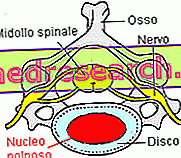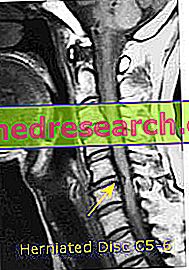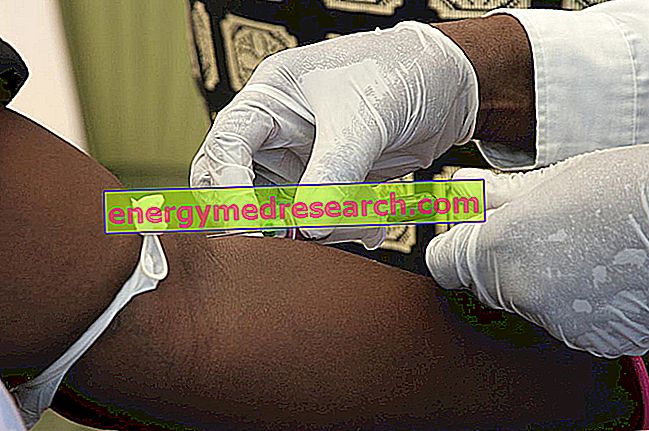Definition of cervical hernia
"Cervical hernia" is defined as a protrusion of the intervertebral disc that compresses the nerve roots directed to an upper limb and, sometimes, also the spinal cord. In other words, the cervical hernia (or hernia of the cervical disc) is a leak of gelatinous material from the pulpy nucleus of an intervertebral disc located in the cervical tract.

Neck pain radiating along the arm (brachialgia) is the characteristic symptom of cervical disc hernia, whose intensity depends on the severity of the pathological condition.
Persistent neck pain, headaches, arm weakness and difficulty moving the upper limb are lit spies of an ongoing cervical hernia. In such situations, the patient should undergo a medical consultation as soon as possible: the clinical evaluation is the starting point for a correct diagnosis and adequate therapy.
Diagnosis
The diagnosis begins with the anamnesis, that is with the collection of data and general information concerning the patient: in this case, the doctor will try to understand the intensity of the pain, the location of the same, the general state of health of the patient and the causes responsible for cervical pain.
The clinical investigation is performed by means of precise maneuvers, useful for highlighting cervical and radicular suffering. For example, the cervical hernia becomes more painful by stretching the neck, while the extension of an arm behind the head slightly attenuates the suffering.
Imaging tests generally constitute the very first diagnostic tests to confirm or deny a suspicion of cervical hernia:
- Computed tomography (CT): diagnostic technique that uses ionizing radiation to obtain detailed images of the cervical area;

- Magnetic resonance of the neck: it can show an abnormal protrusion of the disc and possible compromise of the nerves and spinal cord. Furthermore, RMN shows the ligaments and degenerative bone components, showing at the same time any discal pathologies of the spine;
- X-ray of the neck, useful for having a general idea on the major anomalies at the cervical level;
- Myelography: radiological test performed on the spinal cord. The diagnostic test uses a contrast agent to detect any pathologies or traumas affecting the spinal cord (including cervical localization). The procedure is rather invasive and is followed by puncture in the cervical tract, with the removal of CSF and subsequent injection of contrast medium. Immediately after the procedure, numerous X-ray projections are performed. The test is performed in case of suspected cervical hernia, when the previous evaluations with MRI or CT have given a negative result;
- Discography: rather invasive diagnostic test that involves the injection of a contrast medium in the cervical area to accurately identify the origin of the pain. The test is generally performed only when the cervical pain is so intense that the possibility of surgery is taken into consideration. The discography is always accompanied by a TAC, useful for obtaining more information;
- Electromyography: a useful diagnostic test to identify the muscles involved in the disease.
Differential diagnosis
The differential diagnosis must be made with a hard cervical hernia, soft cervical hernia, arthropathy, osteopathies, rheumatoid arthritis, cervical spondylosis and other degenerative diseases of the cervical spine.
- The investigations necessary for the diagnostic assessment are of exclusively medical competence: the specialist in fact assesses the need or priority of a specific test by carefully analyzing the clinical picture that the patient presents.
Conservative therapies
Therapy for the treatment of cervical hernia can be conservative or surgical.
CONSERVATIVE THERAPY is provided in case of a minor cervical hernia: a similar approach to the pathology suggests the putting into practice of specific maneuvers, mobilizations and manipulations of physiotherapy performed with a certain frequency. The goal of this therapy is to reduce the pressure exerted by the hernia on the nerve root, thus removing the pain.
During conservative therapy, the patient therefore follows a physiatric procedure, which is often associated with a medical therapy consisting of the administration of pain-relieving and anti-inflammatory drugs that accelerate the remission of pain.
The drugs most commonly used in therapy to relieve cervical pain are:
- NSAIDs (non-steroidal anti-inflammatory drugs), useful for lightening pain, at the same time exert an anti-inflammatory action. The active ingredients most commonly used for this purpose are: Ibuprofen, Naproxen, Diclofenac and Acetylsalicylic acid.
- Muscle relaxants, useful for calming muscle spasms caused by cervical hernia. The most used drugs are: Diazepam and Ciclobenzaprina
- Corticosteroid drugs (eg Prednisone, Methylprednisolone and Hydrocodone), exert a powerful anti-inflammatory activity.
- Epidural injection with painkillers / analgesics (for very painful cervical hernia)
Sometimes, the use of a collar can be useful to relieve neck pain after a violent cervical spine trauma: the collar is a support device suitable for reducing cervical movement, preventing further damage.
After achieving a moderate improvement in pain and related symptoms, it is advisable to undertake a specific rehabilitation process, aimed at maximizing the general health of the back (and specifically the cervical tract), very useful also and above all to prevent possible, possible future damages.
Alternative therapies
Even "alternative" therapies are particularly useful for mitigating cervical hernia symptoms:
- Iontophoresis: alternative therapy in which it is possible to administer a drug via the skin using the aid of direct current produced by a generator.
- Acupuncture, useful for relieving pain and inflammation caused by cervical hernia
- Postural gymnastics: the choice of specific exercises and the assumption of a correct posture minimize the pain caused by the cervical hernia.
- Osteopathic treatment: useful for alleviating any nerve impairment in the cervical area
- Spinal nerve stimulation: this particular therapy technique makes use of the aid of the electric current to "awaken" the spinal cord, reducing pain
Surgical therapy
SURGICAL THERAPY is essential when medical / rehabilitation therapy has failed: it is therefore reserved for patients who complain of severe symptoms requiring urgent decompression.
Cervical disc surgery can be anterior or posterior :
- Anterior discectomy + fusion (the most widely practiced for the treatment of cervical hernias): the herniated disc is removed by a small anterior incision of the neck. Subsequently, the disc is replaced with a small bone fragment, generally extrapolated from the patient's own pelvis (or from a compatible cadaveric bone): the process of bone grafting is called "fusion". To simplify the intervention, screws or metal plates are sometimes inserted, in order to facilitate the fusion process and minimize the risk of failure (however quite rare). Treatment requires hospitalization of the patient, who must remain in the clinic for 2-3 days. Full recovery, albeit gradual, takes 7-14 days.
- Posterior discectomy: a much less used therapy strategy, reserved for lateral cervical hernias.
- Artificial Discal Prosthesis Graft that replaces the diseased disc preserving as much as possible the movement and function of the spine. This is an alternative intervention to anterior discectomy followed by intervertebral fusion.
After a discectomy, the patient must observe a period of convalescence of 30-40 days: during this time, the subject must completely abstain from heavy work, must not drive, must not assume incorrect postures and must respect rest .
The operated cervical hernia patient will have to undergo regular routine checks during the post-operative period, to ascertain that the operation is perfectly successful.




